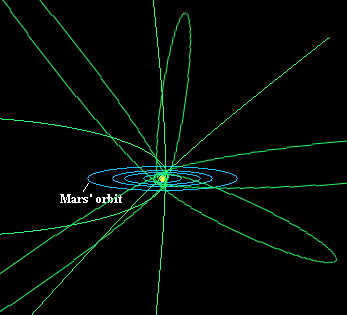 Figure 1.
The orbital paths of comets are very elongated (elliptical) and randomly
oriented to the ecliptic.
Figure 1.
The orbital paths of comets are very elongated (elliptical) and randomly
oriented to the ecliptic.  Image of comet
Hale-Bopp taken by Dr. Morgan, 1997.
Image of comet
Hale-Bopp taken by Dr. Morgan, 1997.
Comets are quite different from planets in how they move around the solar system. While the planets tend to have fairly circular orbits, the orbits of comets are very elliptical, so that they are stretched out from near the Sun to the very edges of our solar system. Some of the orbits aren't even elliptical - the comets just do one passage in toward the solar system and then are gone forever. The orbits are also rather randomly oriented to the ecliptic; they could come in toward the Sun at pretty much any angle relative to the ecliptic. We know that comets are composed primarily of many varieties of ice, including water, carbon dioxide, methane and ammonia ice. There is also a bit of dirt mixed in, usually in the form of carbon. This makes them appear as dirty snowballs, which is actually the name for the model that is proposed for their compositions. The best way to think of a comet is that it is like a big chunk of ice, dirt and slush that gets stuck to the wheel well on your car during the winter.
 Figure 1.
The orbital paths of comets are very elongated (elliptical) and randomly
oriented to the ecliptic.
Figure 1.
The orbital paths of comets are very elongated (elliptical) and randomly
oriented to the ecliptic.
Comets may appear as huge objects in the sky, but they are typically only about 10 km in diameter, much smaller than many other objects going around the Sun. This core or nuclei is how most comets appear when located in the outer solar system (beyond Jupiter's orbit). However, they don't always remain as small, dirty, frozen icebergs. Comets change as they orbit around the solar system, especially when they get into the inner solar system. As a comet moves closer to the Sun, the heat from the Sun will start to evaporate the ices that make up the core of the comet. The material is then in a gaseous state and will form around the core of the comet as a coma, or head of the comet. As the comet gets closer to the Sun, the gas starts getting blown off by the solar wind. Not only is the gas blown off, but also the heavier, dusty material gets blown away. Due to the motion of the comet, which is pretty fast, and the force exerted by the solar winds, the trail that this evaporated material leaves can grow quite large and will develop into tails. The coma can be thousands of times (or more) larger than the cometary nuclei, while the tails can be up to 1 A. U. in size (remember, 1 A. U. is about 100 million miles!).
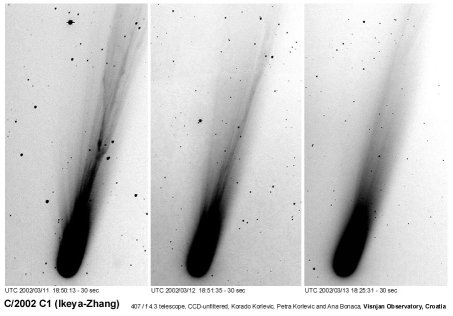 |
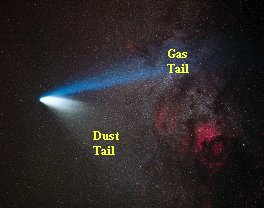 |
|
| Figure 2. To the left is Comet Ikeya-Zhang, which
passed by in 2002. The two tails are not distinct in this image; you
are seeing the gas tail for the most part. I should also mention that
each image is separated by one day, indicating how fast the comet moves
from day to day. Notice also how the tail changes its appearance
from one night to the next. This is mainly due to changes in the gas tail;
the dust tail stays fairly consistent in its shape.
On the right is an image of Comet Hale-Bopp,
taken in 1997. The color differences of the two tails are obvious.
Image copyright ©2002 Korado Korlevic et al. |
||
Two tails are usually seen. These include the gas tail (also called the ion tail), which is made up of material that is blown straight back by the solar wind. This is generally made of the really lightweight gases. Within the gas tail you find stuff such as water vapor, CO, CO2, N2, ammonia and methane gases and particles. The gas tail has a rather ragged appearance and is sometimes rather bluish. It is always pointed directly away from the Sun. The other tail, the dust tail, is made up of heavier particles and is not as greatly affected by the solar wind. It has a very fuzzy appearance, often looking rather yellow-ish or whitish. This is, of course, made up of mainly dust (rocks and silicates). This is much heavier material, so it is not pushed into a straight line like the gas tail but often has a curved shape that is sort of symbolic of comets. Both tails get longer as the comet gets closer to the Sun. Actually, the tails start developing when the comet is still quite a ways from the Sun, well beyond the orbit of the Earth.
Another thing about comets that people are confused by is how fast they move. Comets orbit the Sun, so they obey Kepler's laws, just like the planets. Over the course of an evening it is possible to see tiny motions of a comet relative to the stars, especially if it is close to perihelion, but they don't go streaking across the sky as is often portrayed in cartoons. Think of it this way - you know that the Moon moves relative to the background stars, right? Can you actually see its motion if you sit there looking at the Moon for some time? No, because from our view point it looks like it is hardly moving along, but if you look at it the next evening, you'll see it is in a different location relative to the stars. The same is true for comets; their motions may be apparent from one night to the next, but to see motion with your eyes over the course of a few minutes during one evening would be difficult, if not impossible.
A comet is made up of material that gets evaporated easily by the Sun, so comets lose mass with each passage around the Sun. As much as one percent of their masses can be blown away. Comets may start out very icy, but this is not how they'll look for long, since the ice is the first thing to go. After a while, their nuclei will look very dark and dirty, since the dark, dirty material (mainly carbon) will not get blown away as easily. Comets that can't withstand the strong solar winds can also shatter apart. This has been observed recently in the case of Comet LINEAR (C/1999 S4), and Comet Schwassmann-Wachmann 3, both of which broke apart into smaller pieces. Other comets that pass very close to the Sun can either completely disintegrate or actually hit the Sun! Not all comets that get close to the Sun are doomed. Comet Lovejoy was able to pass very close to the Sun and survive.
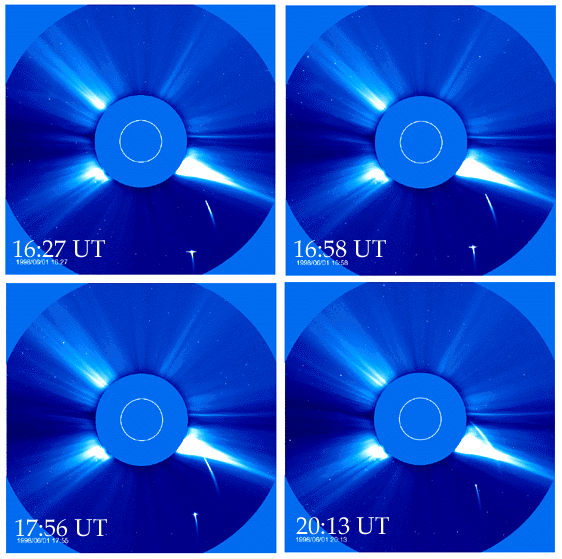 |
Figure 3. Image from the SOHO satellite showing two comets near the Sun. The Sun is not visible in this image, but is blocked by the central disk in the image, but the size of the Sun is indicated by the white circle. The two comets are being destroyed by the strong light and heat from the Sun. To date, the SOHO satellite has discovered more than 1000 comets since 1996. Many, like those shown here, don't always make it past the Sun, but are destroyed by their close passage. To see a movie of comets passing near the Sun, just click here. Images and movies courtesy of SOHO/LASCO consortium. SOHO is a project of international cooperation between ESA and NASA |
Where do comets come from? Comets were originally thought to come from the Oort Cloud, a spherical region that extends about 50,000 AU from the Sun where the cores of comets reside. Every once in a while, the comets are perturbed by a passing star or collision with other comets and some fall in toward the solar system. These comets tend to have orbits that are very elongated. In some cases the comet will only pass near the Sun once. In other cases the comet will have its path altered, usually by going too close to Jupiter, and it will become trapped into a shorter period around the Sun. The existence of the Oort Cloud is based on the characteristics of comets. Many comets tend not to be aligned with the ecliptic, so it makes sense that they originate from a place that surrounds the solar system in all directions. Also, the very long period (greater than 1000 years) comets have paths that stretch out to such great distances that it is logical that they originated at great distances from the Sun. It is estimated that there are about 100 billion comet cores out in the Oort cloud.
There is also evidence that many of the short period comets do not come from the Oort Cloud but from a closer reservoir of cometary material that was previously mentioned (in the last set of notes), the Kuiper Belt. This region is much closer than the Oort Cloud, extending from about 40 AU out to a few hundred AU at most. The characteristics of Kuiper Belt Objects can help explain the shorter period comets (less than 1000 years), especially those with orbits that tend to be closer to the ecliptic. Remember, if the distance from the Sun is smaller, the time for an orbit is smaller - Kepler's Third Law is action.
 Figure 4. The
two comet sources are shown. First is the Oort cloud, located much
further from the solar system, and the second is the Kuiper belt,
located just beyond the orbit of Neptune. Image from Calvin J. Hamilton.
Figure 4. The
two comet sources are shown. First is the Oort cloud, located much
further from the solar system, and the second is the Kuiper belt,
located just beyond the orbit of Neptune. Image from Calvin J. Hamilton.
It seems that there are really two types of comets, with the difference in them evident in the periods of the orbits. Those with long periods (thousands to millions of years) and large orbits (1000 to 30,000 AU) also tend to have very elliptical orbits and to have orbits randomly oriented relative to the plane of the ecliptic. These are likely from the Oort Cloud. Those with shorter periods (a few years to a few hundred years) and smaller orbits (a few AU to 50 AU) could have originated in the Kuiper Belt.
Throughout history comets have scared, inspired or awed people around the world. There are some comets that are well known for various reasons. Also, comets are a popular target for amateur astronomers, since if you find one, it is named after you. This is one of the few things in astronomy that you can have named after you and many amateur astronomers have been lucky enough to find a few. However, this would require years of work, and even if you search for years you might not discover one.
Comet Halley was named after Edmund Halley, who first determined that comets are objects that return to the inner solar system on periodic bases and are therefore predictable. He did not discover the comet that is named after him, but because he "demystified" comets, the comet whose orbit he determined and whose return he predicted is named after him. The comet came by the inner part of the solar system in 1986 and won't come back again until 2061. Its passage in 1986 wasn't very spectacular, and the 2061 trip will probably not be very good either. This comet has gone around the Sun quite a few times, so it has been getting smaller and less spectacular with each passage.
 |
Figure 5. To the left is Sir Edmund Halley, the person who determined that comets are objects that orbit about the Sun, just like planets. To the right is an image of the comet that bears his name as seen during its 1986 passage through the inner solar system. © AAO/ROE, photo by David Malin. | 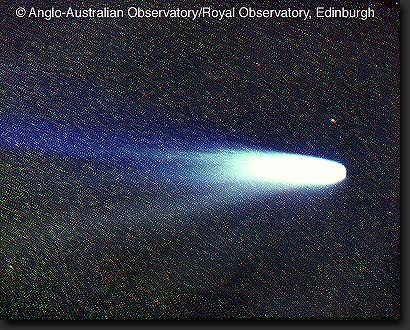 |
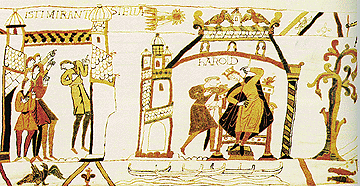 |
 |
| Figure 6. Halley's
comet seen throughout history. The image on the upper left is from a
tapestry showing the comet. This is a portent of doom for the king, in
this case Harold of England, who was to be killed later that year
(1066) in the Norman conquest of England. On the upper right is an
image of the fresco by the Italian painter Giotto with a comet shown
over the adoration of the Magi scene. It is not known for certain
whether this was Halley's comet, but it is likely that Giotto did see
the comet during his life. To the right is an image of the core of the
comet from the Giotto spacecraft. Comet image from NASA/ESA. |
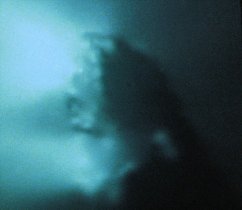 |
Due to its fame, Halley's comet was the target of several spacecraft during its passage through this part of the solar system in 1986-1987. One of the spacecraft was named Giotto after the Renaissance painter who incorporated a comet in one of his frescoes. Giotto flew close to the core of the comet, only about 600 km from it. An animation of the approach can be seen here. At that distance it was able to obtain many images of the comet nucleus, showing it to be a very dark object. This makes sense, because humans have observed Halley's comet for more than 2000 years, and with each passage by the Sun it looses more and more of its ice, leaving behind the dark dirt. Other features observed on the comet were strong venting events, where material was evaporated in a rather explosive manner. These are seen as the bright features in the Giotto image shown above. The power of such vents is pretty great, enough to even alter the comet's orbital path slightly.
 |
 |
 |
| Figure 7. Comet Hale-Bopp seen from the roof of McCollum Science Hall (the observatory is seen in the foreground) and from near Hillside Observatory. In this image, the UNI-Dome is visible in the lower right. The image at right is from a location outside of the city and shows more of the comet's tails. | ||
Comet Hale-Bopp passed by during the Spring of 1997 and came within 1.315 A.U. of the Earth. Even though this is not a really close passage, it was very bright due to its unusually large size, with a core of about 40 km wide. Hale-Bopp is easily the most photographed comet in history. Millions of people observed it since it was easily visible to the naked eye for several months. It was also the third brightest in recorded history. If you missed it, then you must have had your eyes closed, since this was one of the most prominent features in the sky during the spring of 1997.
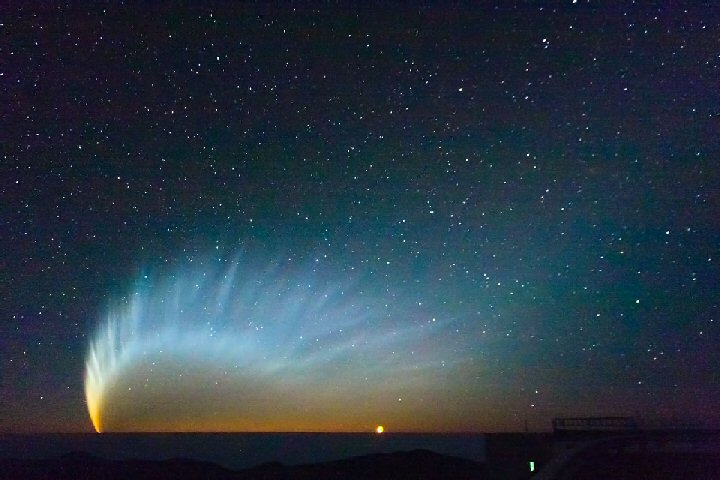 Figure
8. Comet McNaught, as seen in
early 2007. Image courtesy of S. Deiries/ESO
Figure
8. Comet McNaught, as seen in
early 2007. Image courtesy of S. Deiries/ESO
Another recent spectacular comet was McNaught, which passed by in the winter of 2006-2007. Actually the best view was from the southern hemisphere, and boy was that a view. The tail of McNaught was much longer than other comet tails, which led many astronomers to speculate that it came from a very large comet nucleus, perhaps over 200 km in size. Unfortunately McNaught is one of those "one-time" comets which will not return again.
The way that we currently study comets is changing quite a bit. Previously we just were able to only sit and watch them pass by. But recently we've sort of gotten "in their face". The first close encounters were with Comet Halley, when the Giotto space craft flew close to the core. This was followed in January 2004, when the Stardust flew very close to the core of comet Wild 2. During the close encounter with the core, it was able to obtain a sample of cometary material. The spacecraft then flew past the Earth in 2006 and successfully dropped off the collected samples. Currently astronomers are analyzing the material, which is microscopic, to determine the conditions under which comets formed. In general we had assumed that they formed out of only "cold" material, but scientists were surprised to discover several different minerals that only form under conditions of very high temperatures! Also, some icy particles were found that form only in condistion with very low temperatures. How is that possible? It would appear that early in the history of our solar system there was mixing of material from the inner to the outer solar system, so that some of the high temperature material was incorporated into comets. Stardust continued on its journey after dropping off the sample from Wild 2, and visited the comet Tempel 1 (see below) to check on the "damage" caused by another spacecraft. They actually renamed the spacecraft Stardust-NExT since this was a "new" mission. After the encounter with Tempel 1, the spacecraft was sent off into an orbit that would prevent it from hitting the Earth.
The most dramatic comet encounter occured in July 2005 when the Deep Impact spacecraft sent a probe slamming into the surface of comet Tempel 1. Astronomers wanted to break "into" the comet to see what sort of material was below the surface, since the surface of a comet is altered by constant exposure to the Sun and radiation from other sources. Is the ice under the "crust" different? How thick is the surface layer? Results from the impact are still being studied, but there have already been some surprises, such as the how the dust on the surface of the comet is very fine and powdery, something that wasn't expected. The material also seems to be rich in organic matter, material that is rich in carbon. There isn't a great deal of water ice visible on the comet's surface, which means it looks more like a dirt ball with some ice on it, rather that a dirty snowball. It is thought that there is still quite a bit of ice inside of the comet, below the surface. The impact caused the comet to brighten slightly, but that didn't last very long. And like the Stardust spacecraft was re-used to visit Tempel 1, the Deep Impact spacecraft also was sent on a journey to another comet, in this case Hartley 2. To see the view from the spacecraft as it flew by the comet, just follow this link.
In 2015 the European Space Agency's mission to comet 67P/Churyumov-Gerasimenko was rather successful. The Rosetta spacecraft was placed in orbit about this comet and began observing the comet's changing features as it neared the Sun. One aspect that was observed was the emission of material from the comet, such as carbon dioxide, which sort of forms an "atmosphere" around the icy object. Also parts of the comet that can best be described as "sinkholes" appear to emit quite a bit of material. Pictures and details about the Rosetta mission are available here.
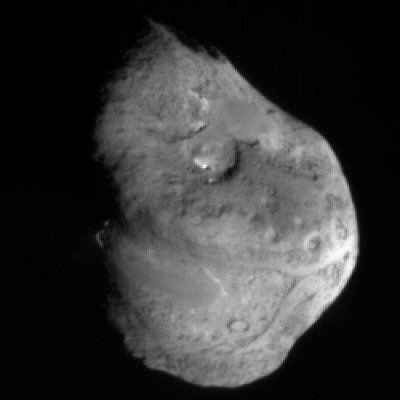 |
 |
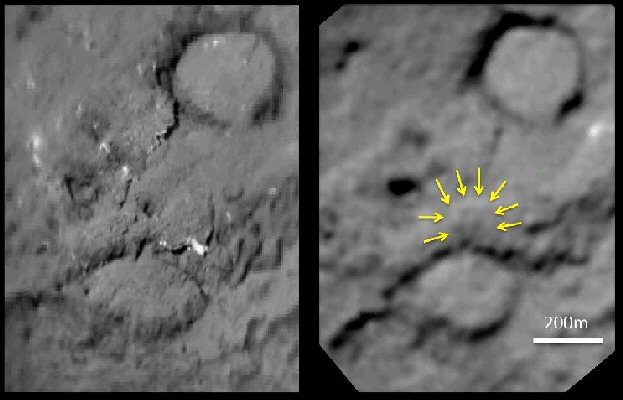 | |
| Figure 9. Image on the top left shows comet Tempel 1 before the impact of the Deep Impact probe. The image in the top right is the view approximately 16 seconds after the impact. The image on the bottom shows the area of the damage before the impact (2005) and the same area as seen in 2011 by the Stardust-NExT spacecraft. The probe hit the comet at a speed of about 10 km/s (6.3 miles per second). You can view a little movie of the impact here and here - one movie is from images taken by the probe as it heads in, the other from the rest of the spacecraft that flew past the comet. Image credits: NASA/JPL-Caltech/UMD/Cornell | |
Many people speculate that comets may have been a source of much of the water on the Earth or even the source for life on the Earth, since very complex molecules have been found in space. As with so many other aspects of astronomy, expect our understanding of comets to change in a few years.
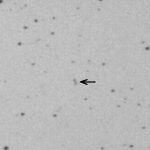 Figure
10. A view of an asteroid
(named Braille) from the Earth. The asteroid appears as a short streak
on the image, while the stars appear to be fixed in their locations in
this long exposure, since asteroids move enough so that their motions
reveal them to be solar system objects orbiting the Sun. Click on the
image to see how far the asteroid moves in half an hour.
Figure
10. A view of an asteroid
(named Braille) from the Earth. The asteroid appears as a short streak
on the image, while the stars appear to be fixed in their locations in
this long exposure, since asteroids move enough so that their motions
reveal them to be solar system objects orbiting the Sun. Click on the
image to see how far the asteroid moves in half an hour.
Asteroids are quite different from comets. Even without looking at them in great detail there are some obvious differences. One thing about asteroids is that they weren't discovered until the invention of the telescope. The first asteroid to be discovered wasn't found until 1801 and was named Ceres. This is also the largest of the asteroids, about 940 km wide. The discovery of more and more asteroids over the years has us believing that there are likely billions of asteroids out there but only a couple hundred larger than 100 km. The vast majority are so small you could easily hold one in your hand. The number of known asteroids changes every month with new discoveries, and there are currently more than 100,000 known asteroids. Unlike comets, asteroids are found relatively close to the ecliptic plane and their orbits are not as stretched out as comets' but are more circular. This is why asteroids are also called Minor Planets. The vast majority of asteroids are found in the asteroid belt between the orbits of Mars and Jupiter. This gives them a typical distance from the Sun of about 2-3.5 A.U. To see the latest plot of asteroids, just follow this link - more than 100,000 objects are plotted.
You may also notice that there are some asteroids located along the orbit of Jupiter, both in front of and behind Jupiter. These are the Trojan asteroids. They are in those locations because of Jupiter's strong pull on them. They orbit the Sun with the same orbital period as Jupiter, so they are always located in the same positions relative to Jupiter, either always before or always after Jupiter. Jupiter has the most trojan asteroids, but Mars, and Neptune also have them, but only a few. In 2011, the first trojan asteroid of the Earth was announced (it has the lovely name 2010 TK7). It is trapped in a location that causes it to always remain in front of the Earth as both travel around the Sun.
There are also asteroids that are found closer to the Sun, and included in this group are the N.E.A. - Near Earth Asteroids. These are the ones we want to pay close attention to since they can cross the Earth's orbit - sometimes they get quite close. Some of these have already been labeled as PHA- Potentially Hazardous Asteroids. Don't astronomers have such fun abbreviations?
Studies of asteroids have been spotty at best. As you'll see, one of the best ways to study them is after they fall to the Earth and are picked up as meteorites, but I'll get to that later. Only on a few occasions have we observed asteroids in their native environment. The Galileo spacecraft obtained images of two asteroids, Gaspra and Ida, on its journey to Jupiter. At rare times, N.E.A.s get close enough to Earth for astronomers to map them out with radar, which provides information on their shapes and surfaces. On February 14, 2000 the NEAR spacecraft went into orbit about the asteroid Eros. It thoroughly mapped and scanned the surface of Eros from that time until February 2001. At the end of the mission, the NASA folks thought it would be cool to see if they could land the spacecraft on the surface of the asteroid - and they did! The darn thing landed fairly safely on the surface, even though it wasn't designed to land. By the way, NEAR stands for Near Earth Asteroid Rendezvous - another one of those cute astronomy abbreviations.
The japanese spacecraft, Hayabusa was able to land on, and take off from an asteroid named Itokawa with a sample of material from the surface. Other observations of this asteroid reveal that it appears to have different densities of material below the surface in its two ends - it isn't made of only one type of rock. It is possible that the asteroid formed by two different objects fusing together. Another asteroid, Charikio, was found to have rings around it, similar to how the rings of Uranus were discovered. The Dawn spacecraft visited the second largest asteroid Vesta in the summer of 2011 and went on to the largest asteroid, Ceres in 2015. Results from Vesta show a surface that has a variety of different minerals on it, including iron and magnesium rich minerals. There is also breccias on the surface, as would be expected from all of the impacts. It also appears that like the planets Vesta has a layered structure, with lower density material near the surface, and denser material near the core. At Ceres, the largest asteroid in the asteroid belt, there was a great deal of interest in very bright white spots on the surface of Ceres. These were not expected, and it is unclear as to their origin. Observations of some of the craters seem to indicate a bit of flexibility in the ice on the surface of Ceres, similar to what we see in the Galilean satellites. Over the next year, more information about Ceres will be provided as NASA scientists analyze the data from Dawn.
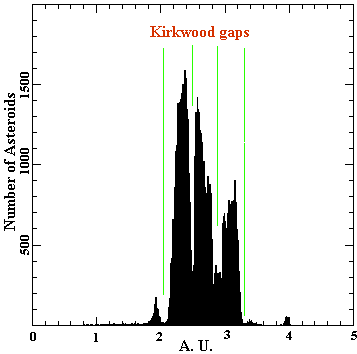 Figure 12.
The distribution of asteroids from the Sun shows prominent gaps, called
Kirkwood gaps. These are caused by Jupiter's gravitational pull.
Figure 12.
The distribution of asteroids from the Sun shows prominent gaps, called
Kirkwood gaps. These are caused by Jupiter's gravitational pull.
After data of the orbits of many asteroids were collected, some rather interesting aspects were seen in their distributions in the asteroid belt. There are a bunch of locations where few asteroids are found. These gaps were first noted by a fellow named Kirkwood, so they are called the Kirkwood gaps. Why are they there? The gaps are seen at places in the asteroid belt where asteroids have orbital periods that are a fraction of Jupiter's, like 1/2, 1/3, 1/4 and so on. When an asteroid has an orbital period that is one of these fractions of Jupiter's, that means that the asteroid and Jupiter will be lined up on a regular basis and Jupiter will be able to pull the asteroid a bit more than normal. Jupiter tends to pull such asteroids out of these resonant orbits and produce the gaps.
Astronomers have only recently been able to get up close views of asteroids, but even without that data we have an idea about what they are made of (or at least what their surfaces are made of) based upon how light reflects off of them and by looking at their spectra. It appears that the compositions of asteroids vary with their distances from the Sun. Those near the orbit of Mars are S-Types (silicate rich, rocky objects), while those further out (about 2.7 A. U. and beyond) are designated as C-Types (carbon rich). There are also some M-Types (metallic composition) mixed in with the S-types. The general breakdown of the various types is that about 75% are C-types, 15% are S-Types, and most of the remaining 10% are M-types. It is possible that the really distant asteroids have quite a bit of ice in them. You'll notice how the asteroid compositions also vary with distance from the Sun and work in quite well with the density variations of the planets - cool, eh? As mentioned, asteroids are very small in size. When an object is very small, it tends to not be circular in shape. Why is that? High gravity tends to make things circular so that all parts have an equal pull inwards. If you don't have much mass to work with, then the gravity isn't really strong enough to pull the stuff inwards, so small asteroids are generally not spherical in shape but tend to be potato shaped, just like the satellites of Mars and the small satellites of the jovian planets.
Why are there asteroids? For some time people thought that the asteroid belt is actually the remains of a planet that got broken apart. This is probably not the case. First of all, if you were to add all the masses of the asteroid belt together, you'd end up with an object that is only a fraction of the size of the Moon! More likely, this is just material that was never able to form into a planet or be incorporated into any other objects. One of the reasons for this is Jupiter. Jupiter's strong gravitational pull would tend to prevent any large object forming in this area, sort of for the same reasons that there are Kirkwood gaps.
If you saw the movie The Empire Strikes Back (one of the early Star Wars movies), you might remember a scene where they are zipping through an asteroid field. This is totally unlike our asteroid belt. Typical distances between large asteroids are on the order of millions of kilometers, not just a few feet. At such great distances the odds of a collision between asteroids is rather low - though not impossible. We know that asteroids have collided in the past (due to some suspicious shapes) and will collide in the future; it's just not a very common event. Some asteroids are actually not a single object but are in several pieces. There are even asteroids that have their own satellites, probably piece of the asteroid that broke off in the past, or flew off due to high rotation rates. In 2009 an asteroid (named 1994 CC) was discovered to have two satellites! However, when an asteroid does collide with another, it is possible that parts of the asteroid can be sent out of the asteroid belt and directed toward us. This could also happen if one of the PHAs gets a little too close to the Earth. In that case, we get into the domain of meteors and meteorites.
What do you think about the existence of swarms of rocky material (asteroid belt), and icy material (Kuiper belt and Oort Cloud) around the Sun? Is it normal for a star to have such variety? Possibly. It is very difficult to see planets around other stars, much less asteroids or comets, but the presence of a belt may be observable. The Spitzer telescope has detected a cometary material belt (like the Kuiper belt), as well as two asteroid belts around the nearby star Epsilon Eridanii. So I guess we're not that unusual after all.
Asteroids also have a wide range of names, unlike other objects in the solar system. Remember, comets are named after who ever discovers it, while asteroids can be named after the person discovers it, or something else they like. There are many asteroids named for cities, famous historical people, some not so famous people, telescopes, entertainers, musicians, fictional characters and so forth. So long as the name isn't offensive or too biased, it will likely be approved. In fact there are so many asteroids discovered our there as part of all these large scale surveys of the sky it is difficult to come up with enough names. You could also discover an asteroid if you want to, by taking part in the Asteroid Zoo, a crowd-sourced searching program. Perhaps you can find one and then you'll get to be famous!
What's the difference between these things? Here's a quick definition of the three
 Figure 13. A
meteor shower is shown in a 15 minute exposure. Some of the
constellations are labeled in this view, which shows many stars
(smallish streaks) which all appear to be moving in a uniform
direction, while the meteors (longer streaks) appear to be radiating
from the constellation of Leo (if you were to trace their motion back).
This is actually a picture from the 1998 Leonid meteor shower, which
makes sense, because that's where it appears the meteors are coming
from. Image copyright Lorenzo Lovato.
Figure 13. A
meteor shower is shown in a 15 minute exposure. Some of the
constellations are labeled in this view, which shows many stars
(smallish streaks) which all appear to be moving in a uniform
direction, while the meteors (longer streaks) appear to be radiating
from the constellation of Leo (if you were to trace their motion back).
This is actually a picture from the 1998 Leonid meteor shower, which
makes sense, because that's where it appears the meteors are coming
from. Image copyright Lorenzo Lovato.
It surprises many people that meteor showers are not due to asteroids but are instead caused by comets. Comets are objects that travel through the inner solar system, so some of their paths intersect the Earth's orbital path. The chance of a collision is not that great, but because the trail of debris left by the comet's passage is rather large, the Earth does pass through that. As the debris is swept up by the Earth and passes through our atmosphere, we have all sorts of bits of ice and rock burning up - that's what makes a meteor shower. This is also how we can predict when the showers are going to occur, since we know where the comet's orbital path is located and when the Earth will pass through it. It is possible to see individual meteors at just about any time of the year, but the dates of showers are when people make an effort to view them. The meteors tend to originate from one location in the sky (since that is where the cometary debris is), so the names of meteor showers are based upon the constellation they are centered upon. Here are some of the main showers, approximate dates, intensity estimates and the comets that are thought to have produced them.
| Shower | Dates | Meteors/hour | Comet |
| Quadrantids | January 3 | 40 | unknown |
| Lyrids | April 22 | 15 | Thatcher |
| eta Aquarids | May 4 | 20 | Halley |
| delta Aquarids | July 30 | 20 | |
| Perseids | August 12 | 80 or more | Swift-Tuttle |
| Orionids | October 21 | 20 | Halley |
| Taurids | November 4 | 15 | Encke |
| Leonids | Nov 16 | 15 | Tempel-Tuttle |
| Geminids | Dec 13 | 50 | Phaethon (asteroid) |
| Ursids | December 22 | 15 | Tuttle |
If you are interested in watching a meteor shower, then you should do a few things. First of all, get far from city lights. You will also have to do some careful planning, since the best observations of meteor showers take place after midnight. You should set up a lawn chair or something comfortable to sit on, since you could spend quite some time looking up at the sky. You may want to bring along something or someone to keep you warm. You do not want to use things like binoculars or a telescope, since you want to view as much of the sky as possible. You just have to sit back and watch the show! Meteors are actually quite a ways up the atmosphere, typically dozens of miles. Most of the objects that are meteors don't survive their passage through the atmosphere but are completely vaporized. However, if objects are large enough and dense enough, they can make it to the surface of the Earth, at which point they become meteorites.
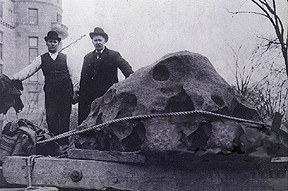 Figure 14. A large meteorite on a wagon. This one
weighs over 15 tons and was found in Oregon. It is the largest
meteorite ever found in the US and the sixth largest in the world. You
can see it today in the Museum of Natural History in New York. You
definitely didn't want to be under this one when it fell.
Figure 14. A large meteorite on a wagon. This one
weighs over 15 tons and was found in Oregon. It is the largest
meteorite ever found in the US and the sixth largest in the world. You
can see it today in the Museum of Natural History in New York. You
definitely didn't want to be under this one when it fell.
Most pieces of cometary debris evaporate in the atmosphere, so most meteorites are thought to originate from asteroids. Just as there are different types of asteroids, there are also different types of meteorites. There are actually three main types. These are -
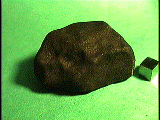 |
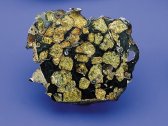 |
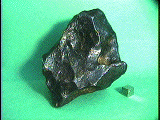 |
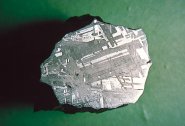 |
| Figure 15. Various meteorites. Starting on the left, a stony meteorite, followed by a stony-iron, an iron meteorite and a sliced iron meteorite showing the Widmanstatten figures. | |||
Meteorites have been floating around in space for so long that they contain material that originates from the time when the solar system formed, and they have not been altered significantly since their formations. Meteorites provide very important information about the early solar system, and the processes that went into the formation of the planets. Meteorites have a wide variety of minerals within them, and the requirements for the formation of those minerals (temperature, density, composition), help us understand the early solar system characteristics. Some of these minerals are very ordinary, like calcite, sulfur and pyrite (fool's gold), but things like diamonds (yes, real diamonds) have been found in meteorites. There are even some minerals that are found only in meteorites. Meteorites also help us determine the age of the solar system through the process of radioactive decay. There is even a group of meteorites discovered in Antarctica that are thought to be from Mars. How is that possible? It is possible that an impact in the past on Mars threw enough material up and away from Mars that it could have eventually made its way to the Earth. The main feature that distinguishes these meteorites from others is the amount of certain gases found in them, which is similar to the atmosphere of Mars in many respects. One meteorite from Mars has been found to contain a significant amount of water and formed at a time in the past when the surface of Mars had more water. A similar process has brought some pieces of the Moon to the Earth as well.
How can you tell if you have a meteorite in your hand? For the stony ones it is difficult. Often the composition has to be analyzed extensively and they should be checked by someone who knows what they are looking for (geologist-chemist). In the case of iron meteorites, there are characteristic patterns in the metal that can be seen - Widmanstatten Figures. They are produced by the heating and cooling of the metal. They are very distinctive and not found in Earth rocks or metals. It also helps if you find your suspected meteorite in a place where there are not too many rocks. Places like Antarctica and large deserts are good places for meteorite hunting, though they are not very nice places to visit.
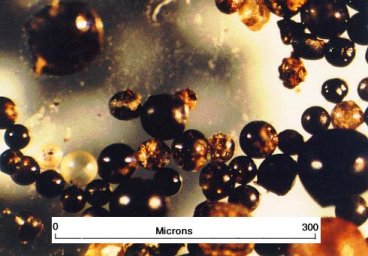 Figure
16. An image of many
micrometeorites from the Cold Regions Research and Engineering
Laboratory of the Army Corp of Engineers. In case you didn't know, 300
microns is 0.3 millimeters in size, smaller than the size of the period
at the end of this sentence.
Figure
16. An image of many
micrometeorites from the Cold Regions Research and Engineering
Laboratory of the Army Corp of Engineers. In case you didn't know, 300
microns is 0.3 millimeters in size, smaller than the size of the period
at the end of this sentence.
It is also rather easy to find meteorites by just setting out a collecting dish in your back yard. Huh? I didn't say they would be big meteorites. Pretty much any location on Earth will have micro-meteorites fall on it. These are really small meteorites that are sort of like dust specks that are continually raining down onto the surface of the Earth. If you set out a bowl of water or a petri dish with petroleum jelly in it, you'll catch of a few meteorites after some time - along with bugs, pollen, regular dust, etc. You'd have to use a microscope to find the micrometeorites. They tend to very spherical.
Finding meteorites on the Earth may seem like a difficult task, just imagine how difficult it is to find a meteorite on another planet. Or is it? The Mars rover Opportunity has found a pretty good sized meteorite on the surface of Mars, which is about 2 feet across. Since the rover has the ability to chemically analyze rocks, it was able to determine that this meteorite (shown here) is an iron meteorite.
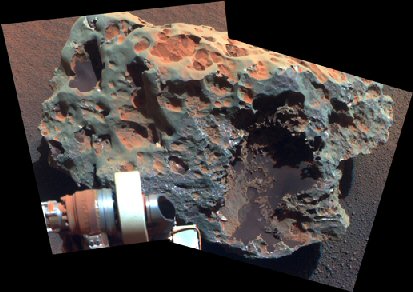 Figure
17. Meteorite
discovered in 2009, on the surface of Mars. Image from NASA/JPL - Caltech/Cornell University.
Figure
17. Meteorite
discovered in 2009, on the surface of Mars. Image from NASA/JPL - Caltech/Cornell University.
Obviously, if some meteors can make it all the way to the surface of the Earth and become meteorites, it is possible for even larger objects to strike the Earth. This has happened quite a bit in the past and it will happen in the future - we just don't know when. Even within the last 100 years, people have had some near-misses with meteorites. In 1938 a woman in Illinois heard a sound in her garage and went out to find a meteorite sitting on top of her car. A few years later a woman in Alabama was hit by a ricocheting meteorite that gave her a really nasty bruise on her hip. In 1971 a house in Wethersfield, Connecticut was hit by a meteorite. Eleven years later, a house about one mile away was hit by another meteorite. One of the best recorded impacts was of an object that smashed through the trunk of a woman's 1980 Chevy Malibu. This happened in 1992. The woman was offered $69,000 for her wrecked car, which was a real bargain (since the car was 12 years old and rather run down). The meteorite that did the damage was 30 pounds. The path that this particular piece of space debris took was recorded by many observers in the eastern US, and one person filmed it (they were actually at a high school football game when they caught the images, which can be seen here).
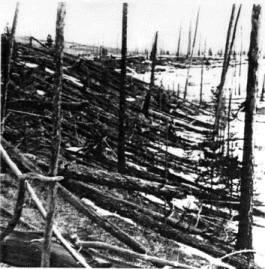 |
Figure 18. At left, the damage to the forest of Tunguska by the impact there. At the right is the blast area, where trees were knocked down, superimposed on a map of Iowa. The force of the blast extended much further than this region, though. This only shows where the trees fell. | 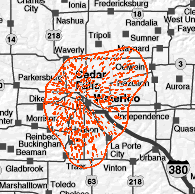 |
These are all really small things; what if a really big thing hit the Earth? If you want to see the effects of very large impacts, you need only go to Arizona to see a large impact crater. There are also craters visible in other parts of the world, like Australia, Canada and Africa. However, these are pretty old impacts, most pre-dating human history. A big impact that occurred not too long ago took place in remote Siberia. At about 7:17 AM on June 30, 1908, an object struck the Tunguska region of Siberia. The glow of the fire from the impact was visible 1000 km from the site. People 60 km from the impact site were knocked down by the force of the shock wave. The night sky was kept bright by the fires ignited by this event. Actually, people as far away as England noted the overly bright night sky during that summer. Some records indicated that the sky was so bright that you could read a newspaper at midnight. Barometers around the world measured a change in air pressure as the blast wave traveled around the Earth several times. It wasn't until the 1930s that a team of scientists finally reached the site, since it was located in remote swamp lands. No meteorite fragments were found, but the forests in the region were either flattened or burned. Also, based upon the tree pattern, it appeared that the object did not actually hit the ground but exploded in the atmosphere. It is most likely that the object was a comet, since it would have shattered much more easily than an asteroid and would have been easily dissolved. If the object was an asteroid, there should have been more pieces of meteoritic material in the area. Either way, it was pretty devastating. The main casualties in the area were herds of reindeer and one man who was knocked to the ground by the blast and died of internal bleeding. The impact had the strength of roughly a 40 megaton nuclear bomb (about 1000 times as powerful as the bomb that fell on Hiroshima).
 |
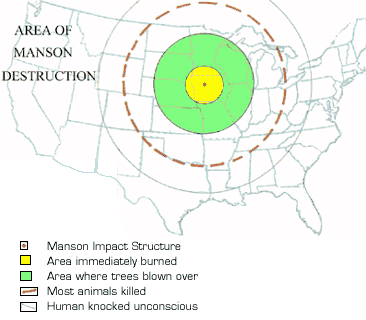 |
| Figure 19. Earthly
impacts. The crater in Arizona looks pretty impressive but is only
considered a small impact. The impact in Iowa, shown on the right, was
much more powerful and caused a greater amount of damage. Arizona
crater picture courtesy of USGS, D. Roddy. Manson impact site image
from the Iowa Geologic Survey. |
The Tunguska impact was certainly quite large, but what about an impact in a region where a lot of people live? A close call occurred on February 15, 2013 when an object exploded over the city of Chelyabinsk, a city of over a million people in east central Russia. The object's passage through the sky was impressive. What was even more impressive, and much more dangerous, was the shock wave produced by the explosion. This hit the ground about two minutes after the passage of the object. So as people were still gazing out their windows trying to figure out what happened, many windows were shattered. Over 100 people were injured because of the blast wave which came from an object that weighed perhaps as much as 6 tons as it exploded. Most of the time even relatively large objects never strike the Earth, as can be seen in this study, that tracks the more than 500 impacts that exploded in the atmosphere over a 20 year span.
What about other big impacts? Most other impacts are so far in the past that we only see the damage after the fact. Some were pretty big. Probably the most famous impact feature is the one in Arizona. However, that was produced by an impact producing only 3.5 megatons of TNT - pretty puny compared to other impacts. One of the biggest impacts on the Earth took place in Iowa, near what is now the town of Manson (near Fort Dodge). That impact occurred about 74 million years ago, so most traces of it are not visible. However, it was much more powerful than the Arizona impact. It packed a punch of about 1/2 million megatons of TNT. The area of damage was pretty extensive at the time. The image above shows just how nasty such an impact would be if it happened today. Another impact crater was recently discovered under the city of Decorah. This impact was even older, occurring about 470 million years ago, so all evidence for it is below ground - nothing on the surface could last that long.
Of course, we have been seeing evidence of damage on other worlds. Only recently have we been lucky enough to see a major impact on a world. In 1993, a comet named Shoemaker-Levy 9 (SL9 for short) was discovered. There's nothing too unusual about that, but when further observations showed the motion of the comet to be in orbit about Jupiter (and not the Sun), interest increased. Interest in SL9 intensified when it was determined that this comet wasn't just in orbit about Jupiter but was actually on a collision course with the planet. A previous passage around Jupiter had caused the comet to break into about 20 chunks. This meant that for about one week, we could watch 20 pieces of cometary debris, some about 1 km in diameter, smash into the cloud layers of Jupiter from the safety of the Earth - and boy, was it a cool show! Infrared cameras showed large explosions occurring as each fragment hit, and as Jupiter rotated around, we could see dark cloud features, sort of like cosmic black eyes, on the clouds. The largest fragment had an impact energy of 6 million megatons of TNT (think of that - it was 12 times more powerful than the Manson impact!) The temperatures produced by each explosion was much greater than the temperature of the Sun's surface. The spots that were left by the impact were larger than the Earth in size. Jupiter wasn't damaged by the impact, and evidence of the impacts was gone in a few months, but for a while it was the best show around.
If you missed it, odds are you won't be able to see such an event again. Such an impact event has the chance of occurring only once every thousand years... Or so we thought. In July of 2009 an amateur astronomer noticed a new spot on Jupiter that appeared literally overnight and looked very similar to the spots left by Shoemaker-Levy 9. So perhaps the "once-in-a-life-time" estimate that we thought wasn't quite correct. The Hubble Space Telescope took some images of the new spot, which will likely last only a few months. You can see those images here. And it also appears that someone has caught an impact on video - not what you'd see on America's Funniest Home Video, but still very interesting. Here is a link to the video.
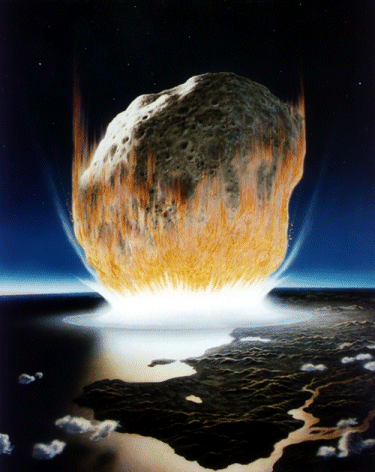 Figure 21. Something
that will happen in the future. Let's just hope we're not around when
it does happen....Painting by Don Davis, for NASA.
Figure 21. Something
that will happen in the future. Let's just hope we're not around when
it does happen....Painting by Don Davis, for NASA.
Certainly impacts have happened on the Earth, but are they really that bad? Most of the craters we see today, from relatively recent impacts, are relatively small, so we should have no problem surviving an impact, right? Well sometimes, as in the case of Tunguska, we don't have an impact feature and the effects can be devastating. Some scientists propose that 12,900 years ago, a comet exploded over North America, which caused global cooling and the start of the Ice Age. This may have led to the extinction of large North American mammals. A nice theory, but there are many proponents that point out flaws in the data and evidence - some of which may not be extra-terrestrial in origin. A major impact on the Earth would be devastating, but do we really have to worry about it happening?
The odds of impacts by large objects are pretty rare. However, they can and will happen. Here is a graph showing the level of devastation caused by such impacts and their frequencies. Those that cause global destruction are pretty rare. However, they are still possible. Right now (August 2011), there are many objects that have very, very, very slight chances of hitting the Earth. One of these with the very small chance of hitting the Earth is asteroid #99942, Apophis (also called 2004 MN4), which was initially calculated to have a 1 in 45,000 chance for an impact on April 13, 2036, however after further observations of its orbit, that chance has dropped to about 4 in a million. In case you were wondering the name Apophis is the Greek name for the Egyptian god of evil, destruction and darkness, and he's a character on the Sci-fi show Stargate. Seems like they wasted a really cool name on an object that isn't going to hit us. One thing that is worth noting is that Apophis will come very close to the Earth in 2029, perhaps close enough that its orbit is changed enough to make a future impacting object. So even though the immediate danger doesn't exist, things can change in the future.
The object that currently has the best chance of hitting the Earth is asteroid 2010 RF12, which doesn't have any cute name associated with it (looks like we want to be sure before we give it a really nifty name). It has a 1 in 17 chance of hitting the Earth on September 6, 2095. Click here to see its orbit. This information can change in the future when more measurements of the objects motion are completed, or if another object is discovered that has an even higher chance of hitting the Earth.
At this point, there is a growing list of objects that we know of with a small chance of hitting the Earth. There are many other objects out there, the PHAs, that have even lower probabilities of hitting the Earth. Now, you may notice that I wrote the words "that we know of" with some emphasis. That's because the job of finding these critters isn't easy and there are not that many people who are actively looking for them. In fact, in February of 2011, an object came relatively close to the Earth (less than 6000 km from us, or about 0.85 Earth radii) and we didn't know about its existence until 14 hours before it flew by! In fact this one was so close that the Earth's gravity changed its orbit. Just keep in mind that sometime in the future we'll get hit again, and whether it is tomorrow or 1000 years from now, there is no avoiding the fact that it will happen.